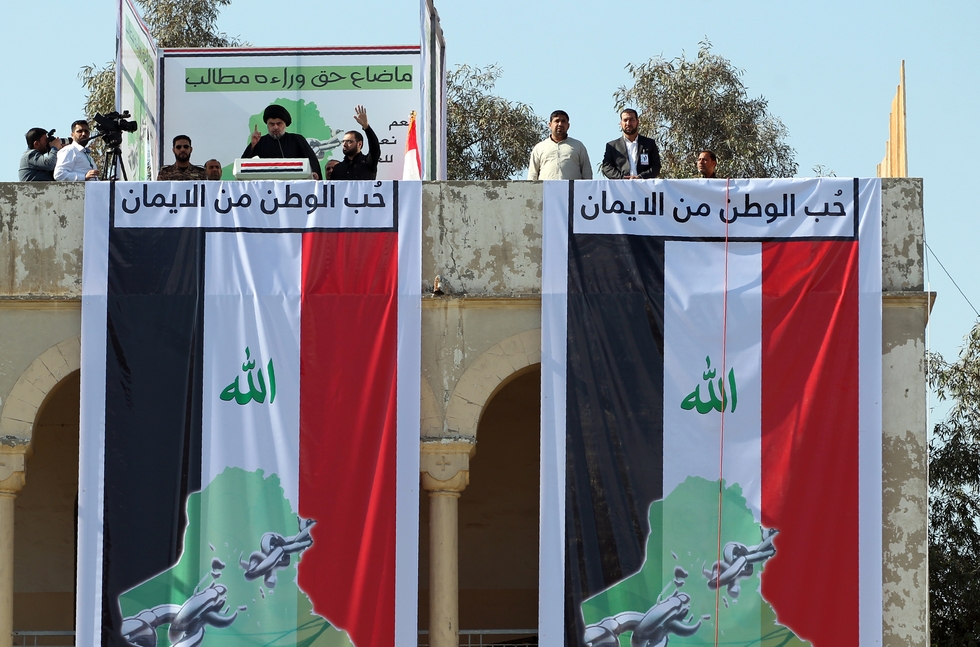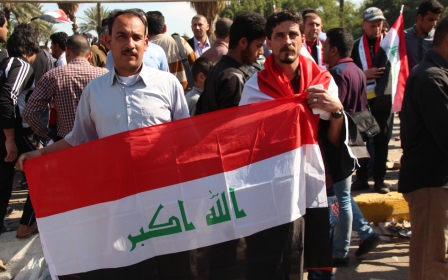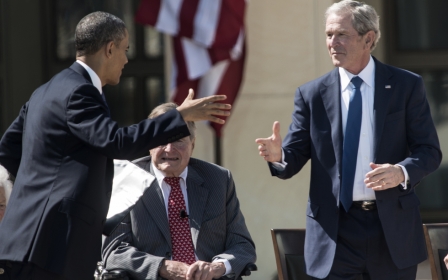Iraq's Sadr didn't storm the Green Zone, but sent a clear message

Mobilising tens of thousands of supporters in Baghdad’s Tahrir Square chanting his name and waving the Iraqi flag, Muqtada al-Sadr recently returned to the public spotlight.
After years of relative quiet, his grand reappearance underpins future political ambitions. Sadr’s potential role is worth analysing in detail as he is a powerful Shia leader who both challenges Iranian influence and appears to pursue a nationalist policy that seeks to overcome the deep sectarian trenches Iraq is suffering from.
However, his aims remain difficult to fathom as his history is dynamic and he represents a hybrid of anti-establishment positions while being part of the establishment himself.
After the US invasion of 2003, Sadr’s Mahdi army fought a bloody war against the Americans, Sunni militias and elements of the Iraqi state, such as the Iranian-backed Badr militias who had become part of the Iraqi security forces.
The civil war reached its peak in 2006 and so did the Mahdi army’s violence. It became infamous for its cruelty and discredited the whole Sadrist movement. The sectarian-focused violence highlighted the Sunni-Shia divide that laid the foundation for the rise of what would later be called the Islamic State (IS). Under pressure, Sadr disbanded the Mahdi army but the structures remained. His retreat did not mean he or his political movement has been inactive in recent years.
From troublemaker to reformer?
Especially since 2011, there has been a shift in his rhetoric. Sadr has emphasised social justice as well as good governance and promoted the idea of national unity. A Shia leader himself, he challenged former prime minister Nouri al-Maliki’s pro-Shia political course and sympathised with Sunni demonstrations that flared up at the end of 2012 in several cities. After IS took over large areas of Iraq in 2014, Sadr called for the reformation of his militia.
To distance the former Mahdi army from its violent past, he renamed it Saraya al-Salam, the Peace Companies.
The Peace Companies are part of the Popular Mobilisation Units, an umbrella of Shia militias that was formed in 2014 to confront IS.
Unlike other militias under Iranian control which send fighters to support the regime of President Bashar al-Assad in Syria, Sadr endeavours to highlight the Peace Companies’ independence in general and from Tehran in particular. Yet, Shia militias that are active in Syria can often be connected to the Mahdi army - such as Kataib Hezbollah, which emerged as a Mahdi army successor.
Contrary to the past, however, the Peace Companies fight together with the Iraqi security forces and do not separate themselves from Sunnis in general. Sadr’s father and founder of the Sadrist movement, Grand Ayatollah Mohammed Mohammed Sadiq al-Sadr, was an Iraqi nationalist who took an anti-Iranian stance. It was this climate that influenced his son and explains Sadr’s rejection of Iranian influence to some extent.
In his speech last Friday, Sadr presented himself as the voice of the people, criticising corruption and the Iraqi government’s inaction.
"Today I am declaring that none of the people who are in the government are representing us, regardless of whether he sympathises with us or belongs to us," he said in front of his supporters.
However, his al-Ahrar bloc won 34 seats in the 2014 elections and holds three cabinet posts. Sadr is embedded in the Iraqi political establishment and some criticise him for being inauthentic.
His speech wasn’t opposing the government in general though. In fact, Sadr called for support for the politics of Haider al-Abadi, the current prime minister who has found himself under pressure from pro-Iranian politicians and militia leaders who confront his reform plans.
Sadr has a fairly distinct profile. First, he is an influential Shia cleric, militia leader and politician who publicly rejects foreign influence. Second, his nationalist approach opposes sectarianism. Considering Iraq’s present state, characterised by a heavily Shia-Iranian-influenced central government, the Sadr approach could offer an opportunity for inclusion that Iraq’s disrupted society deeply needs.
On the other hand, Sadr’s motives remain unclear, and so far there is no proof that he is committed to the idea of the country’s constitution and the rule of law. In his speech he threatened to storm the Green Zone, the heavily fortified area in Baghdad which is home to government buildings and foreign embassies.
That is likely to be understood symbolically because Sadr lacks the political and military resources as well as incentives for such an undertaking. Nonetheless, the message is strong.
Time will tell if Sadr’s spectacularly staged reappearance will be followed by concrete action, but one thing is certain: the Iranians will be watching the situation closely as the movement challenges Tehran’s influence in the long term.
- Lars Hauch studied International Development in Vienna and worked as head of editorial at the German media outlet Commentarist. With a focus on the MENA region, he published a commented roundup www.menaroundup.com, in addition to writing for EAWorldview and the German CARTA.
The views expressed in this article belong to the author and do not necessarily reflect the editorial policy of Middle East Eye.
Photo: Iraqi Shia cleric Moqtada al-Sadr (Top-L) delivers a speech to his supporters during a demonstration in Baghdad's Tahrir Square on 26 February, 2016, calling for governmental reform and elimination of corruption (AFP).
New MEE newsletter: Jerusalem Dispatch
Sign up to get the latest insights and analysis on Israel-Palestine, alongside Turkey Unpacked and other MEE newsletters
Middle East Eye delivers independent and unrivalled coverage and analysis of the Middle East, North Africa and beyond. To learn more about republishing this content and the associated fees, please fill out this form. More about MEE can be found here.





